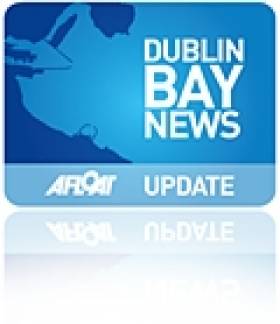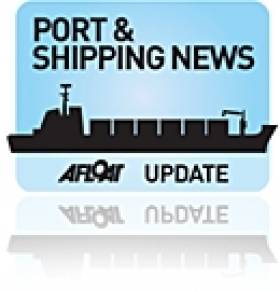Displaying items by tag: Dun LaoghaireHolyhead
Stena to Re-Introduce HSS this Week
Stena Line's HSS fast-ferry the Stena Explorer will be re-introduced on its Dun Laoghaire to Holyhead route this Friday, writes Jehan Ashmore.
The HSS (High Speed Service) operated 19,638 tonnes craft will run between 1 April to 13 September to cope with the additional demand over the summer period.
A single daily round trip is scheduled with a 10.00 hours sailing from Holyhead and a 13.15 hours sailing from Dun Laoghaire. Passage time is 120 minutes (2 hours).
The HSS can 350 vehicles and with 1500 passengers, the craft can handle higher volumes of seasonal summer foot passengers compared to the last route serving vessel, the 4,113 tonnes Stena Lynx III. The return of the HSS service links in with those intending to make onward journeys from Dun Laoghaire's DART commuter rail service to Dublin city centre and beyond on the national rail network.
Up to early January the route had been served by the Stena Lynx III which remains moored alongside Dun Laoghaire's St. Michaels Wharf. The craft which can take 627 passengers and 120 cars and marketed as the Stena 'Express' is to resume high season sailings starting in July between Rosslare-Fishguard.
In total the company carries over two million passengers on its four Irish Sea routes each year. An additional route between Belfast-Liverpool (Birkenhead) was taken over by the Swedish owned ferry company from DFDS Seaways late last year, is subject to regulatory clearance.
Until such clearance has been granted, this route will be operated separately from all other Stena Line routes. In the meantime the company advise until further notice to make bookings which will remain acceptable through the use of the DFDS website.
HSS Fast-Craft to Return on Dun Laoghaire Route
According to Stena Line over 70% of its passengers business is carried by the HSS Stena Explorer in the high season. It is felt that the 1996 Finnish built fast-craft is better suited for the service due to a loyal customer base which was reflected by repeat bookings and their preference of the HSS craft on the 120 minute (2 hour) route.
A daily single round trip is scheduled with sailings from Dun Laoghaire to Holyhead departing at 13:15hrs. The corresponding sailing from the Anglesey port departs at 10.00hrs and arrives at the Irish port at 12 noon. Sailings will operate through the summer until 13 September.
From there on Stena will make a decision as to its continuing schedule, though it is widely believed that the prospects of the fuel-thirsty, expensive to run HSS fast-craft service are likely to be at an end of an era.
Last month negotiations over the core issue of harbour fees were held between Stena Line and Dun Laoghaire Harbour Company. It is understood that the annual fee of €6.5m was dropped to €2m. The board of the harbour company has given a 'conditional green light' of a new ferry contract to Stena Line to run the service for the next two years with an option of a third year.
The service closed for its seasonal break earlier this year on 5 January with the 'Lynx' going into temporary lay-up at Holyhead's inner harbour to join the HSS Stena Explorer. The HSS had been 'wintering' at the port since September sailings were taken over by the Lynx.
Earlier this month the Stena Lynx III came to Dun Laoghaire to continue her lay-up period. The 1996 Tasmanian built craft will stay there before resuming seasonal sailings between Rosslare-Fishguard in tandem with the conventional ferry Stena Europe.
In the meantime the craft is berthed at the harbour's two-berth ferry terminal at St. Michaels Wharf. The HSS berth is only designed for this type of fast-craft whereas the other berth now occupied by the Lynx was built originally for conventional ferries but was re-configured last year to suit the fast-craft.
Dun Laoghaire Harbour Invites Public's Views on Masterplan
The Dun Laoghaire Harbour Company has invited the public to submit their ideas about the future of the harbour. A masterplan is to be developed so to address the changing emphasis of the harbour from a commercial harbour to a recreational harbour and the impact of change in the profile of ferry sailings on the Dún Laoghaire - Holyhead route. For further details please logon HERE In addition a map of the harbour, showing the extent of the area concerned.
The 'Lynx' Returns to Dun Laoghaire
on the Dun Laoghaire-Holyhead route, writes Jehan Ashmore.
ferry Stena Europe on the Rosslare-Fishguard route. Prior to then the Lynx craft also served Spring
sailings on the Dun Laoghaire-Holyhead service as a replacement vessel of the HSS Stena Explorer.
The reasoning for the change of vessels on the central Irish Sea route during the Spring and
forthcoming Autumn /Winter seasons is a cost-cutting measure on behalf of operators Stena Line.
The larger HSS craft is becoming increasingly more expensive to run using fuel thirsty gas-
turbine engines, compared to the smaller capacity Stena Lynx III, which can be used instead
during the quieter months.
Stena Explorer is to be withdrawn with the last round trip sailing tomorrow (14 September)
departing Holyhead at 10.00hrs and arriving at Dun Laoghaire at noon. Correspondingly the HSS departs
the Irish port at 13.15hrs and returns to the Welsh port two hours later.
On the following day (15 September) the Stena Lynx III will make her first outbound departure
from Holyhead at 10.00hrs arriving Dun Laoghaire at 11.50hrs. After a turn-around period in the Irish port
the Lynx departs at 13.15hrs with an arrival to the Anglesey port at 15.05hrs.

































































